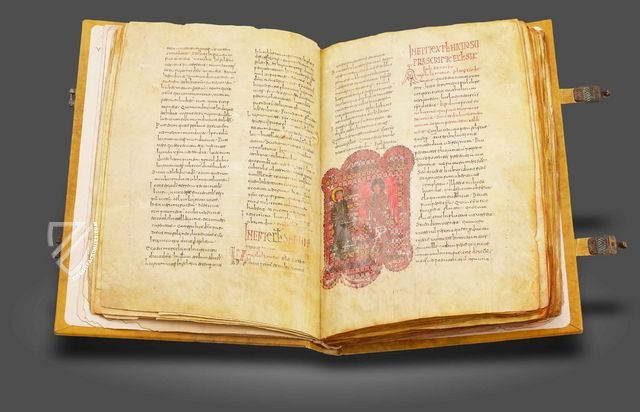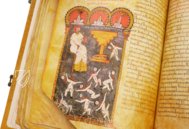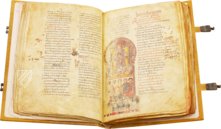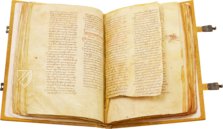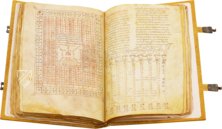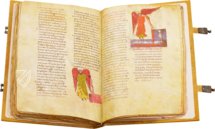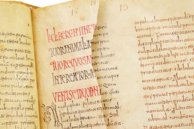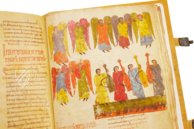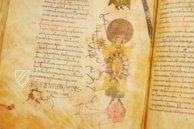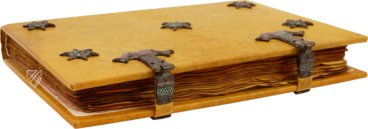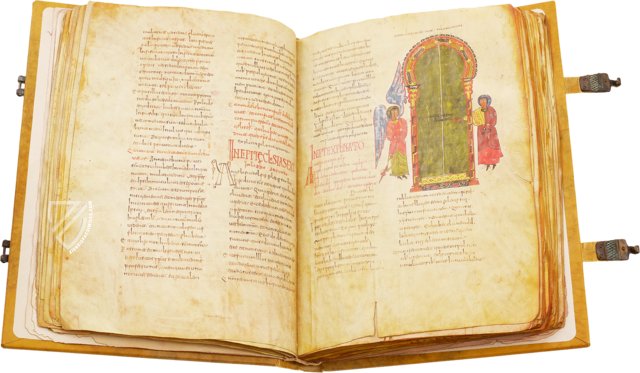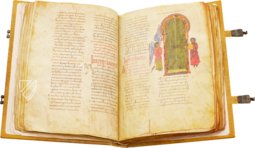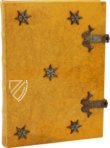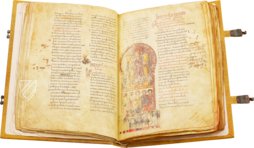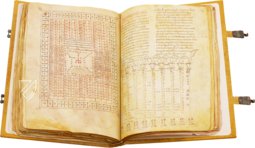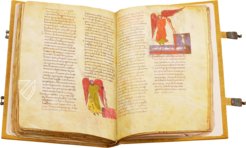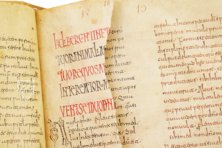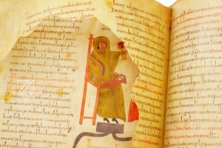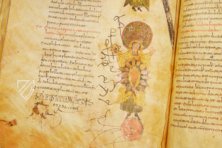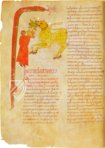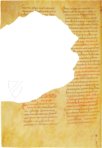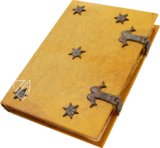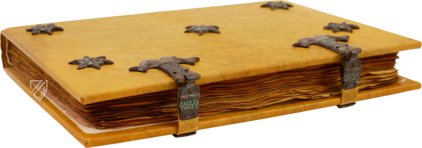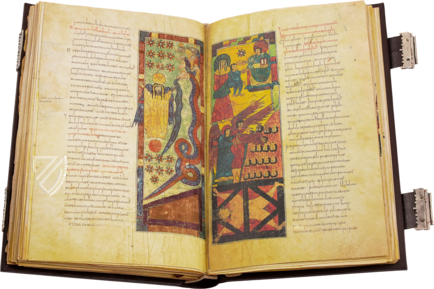Beatus of Liébana - Emilianense Codex
(3,000€ - 7,000€)
The Commentary on the Apocalypse by Beatus of Liébana was one of the most popular theological works of the Middle Ages, which is attested to by the more than two dozen illuminated manuscripts of the work that have survived to the present. Known as the Emilianense Codex, this manuscript has a unique position as one of the oldest specimens of the Beatus tradition. Created ca. 930, it features 27 brightly colored miniatures incorporating influences from Moorish and Late Antique art that feature figures in flowing robes with wide eyes and expressive gestures.
Beatus of Liébana - Emilianense Codex
The Emilianense Codex is an illustrated Beatus manuscript that counts among the earliest specimens of these codices, which were universally popular in the Middle Ages. Originating ca. 930 in the north of Spain, the codex contains the Apocalypse Commentary of Beatus of Liébana in its original form and is almost unique in that way. This historically valuable content was completed with 27 miniatures that lead the apocalyptic events before one’s eyes in powerfully colorful pictures.
A Splendid Contemporary Witness
The so-called Emilianense Codex originated ca. 930 in the scriptorium of the Sahagún Monastery in northern Spain. Beatus of Liébana composed his famous main work only 150 years before the scribes and miniaturists set to work on this Romanesque book treasure. This commentary on the Apocalypse of John in 12 books (ca. 776) found wide distribution in the Middle Ages and was recorded in Spain in particularly splendid manuscripts. 27 illustrated specimens of these identified Beatus Codices are still known today. The Emilianense Codex counts among the oldest, along with the Beatus of San Miguel de Escalada, of those stored in the Morgan Library in New York.
The Original Text of Beatus
The exterior of the codex already allows the exciting content of the book to be unlocked. The leather binding with brass clasps was adorned with star-shaped fittings. The 288 large-format vellum pages also lend a noble air to the manuscript. The Beatus text is divided into two columns and is continuously broken up by admittedly simply colored, yet artfully contoured initials. Additionally, 27 surviving, brightly-colored miniatures adorn the text (originally the codex contained more than 60). Sometimes these show only one or two figures, which illustrated the text, at other times they show group depictions with the hosts of angels.
Captivating Miniatures
Puffy garments and naively depicted bodies characterize the style of the figures, whose faces are artfully designed with big eyes and expressive gestures. Yet these figures practically disappear in the ornamentally well-structured background. The fine and detailed configurations of the miniatures are reminiscent of Arabic ornamentation. In parts the miniatures are framed by organic decorative borders, in other parts architectural elements make up the background. Yet this design, gorgeous at first glance, is fractured on closer inspection through the often gruesome pictures, such as (by the opening of the Fifth Seal) bleeding heads lying next to their naked corpses, or the unvarnished scene of a beheading. The great number of angels, who populate the miniatures, many with beautiful wings, is striking. The depictions of animals also amaze in their creative naivety, sometimes the tiger or the lion, frogs, or the artfully embellished snake. The manuscript was stored in the San Millán de la Cogolla Monastery and came to Burgos in the 19th century. Serafín Estébanez Calderón, a famous politician and great lover of books, acquired the codex for his collection. Through him, the so-called Emilianese Codex finally reached the Spanish National Library in Madrid, where it is housed today.
Codicology
- Alternative Titles
- Beatus Emilianense de la Biblioteca Nacional
Beato Antiguo
Beato Primero
Beatus de Liébana - Size / Format
- 288 pages / 35.0 × 25.0 cm
- Origin
- Spain
- Date
- Ca. 930
- Epochs
- Style
- Genre
- Language
- Illustrations
- 27 miniatures
- Artist / School
- Beatus of Liébana (died after 798) (author)
- Previous Owners
- Monastery of San Millán de la Cogolla (La Rioja)
Monastery of Burgos
Serafín Estébanez Calderón
Spanish Ministry of Public Works
Beatus of Liébana - Emilianense Codex
Musicians of the Apocalypse
Bowed instruments appeared in Spain during the 10th century, making this one of the earliest depictions of them. These four musicians are playing some sort of early viola but hold it upright in the manner of a cello rather than under the chin. Each is depicted wearing a different colored robe with decorative stripes, and their instruments are all dyed a different color as well. The three musicians on the left also appear to be following the lead of their darkly dressed colleague on the right.

Beatus of Liébana - Emilianense Codex
Harvest and Winepress
An oft-repeated metaphor in the Book of Revelation for how God will separate the blessed from the wicked is that of winemaking, specifically the imagery of the harvest and of separating the wine from the stems, skins, etc. The winepress thus represents the punishment of the wicked and their expulsion from the community of the saved.
A vine connects the earthly harvesters, one of whom is cutting wheat, with their angelic overseers in Heaven, which is represented by an altar at the top of the page. Meanwhile, the bottom register shows a realistic depiction of a medieval winepress: “So the angel thrust his sickle into the earth and gathered the vine of the earth, and threw it into the great winepress of the wrath of God.” (Rev. 14:19)
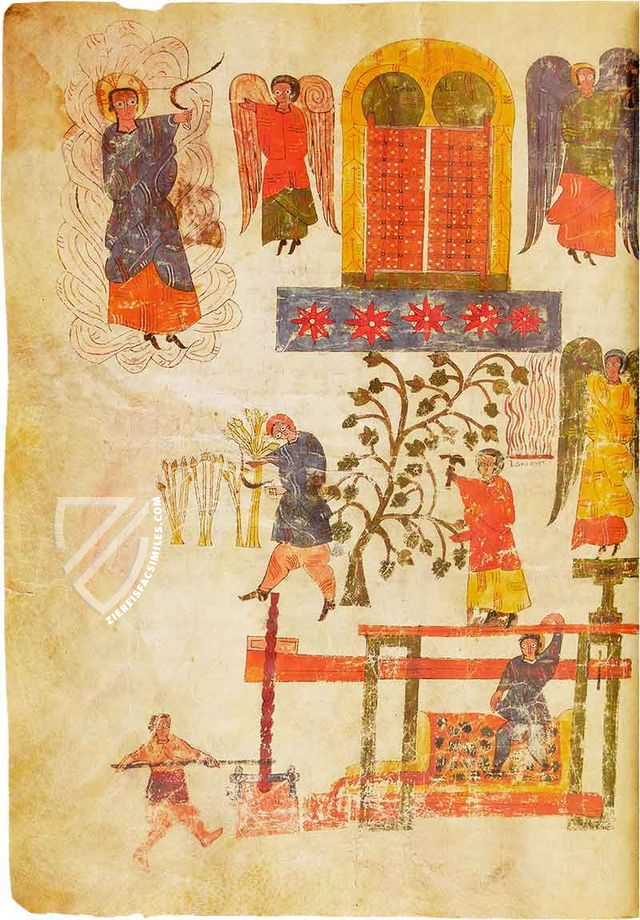
#1 Beato Emilianense de la Biblioteca Nacional Beatus of Liébana - Vitrina 14-1 Codex
Language: Spanish
(3,000€ - 7,000€)
- Treatises / Secular Books
- Apocalypses / Beatus
- Astronomy / Astrology
- Bestiaries
- Bibles / Gospels
- Chronicles / History / Law
- Geography / Maps
- Saints' Lives
- Islam / Oriental
- Judaism / Hebrew
- Single Leaf Collections
- Leonardo da Vinci
- Literature / Poetry
- Liturgical Manuscripts
- Medicine / Botany / Alchemy
- Music
- Mythology / Prophecies
- Psalters
- Other Religious Books
- Games / Hunting
- Private Devotion Books
- Other Genres
- Afghanistan
- Armenia
- Austria
- Belgium
- Belize
- Bosnia and Herzegovina
- China
- Colombia
- Costa Rica
- Croatia
- Cyprus
- Czech Republic
- Denmark
- Egypt
- El Salvador
- Ethiopia
- France
- Germany
- Greece
- Guatemala
- Honduras
- Hungary
- India
- Iran
- Iraq
- Israel
- Italy
- Japan
- Jordan
- Kazakhstan
- Kyrgyzstan
- Lebanon
- Liechtenstein
- Luxembourg
- Mexico
- Morocco
- Netherlands
- Palestine
- Panama
- Peru
- Poland
- Portugal
- Romania
- Russia
- Serbia
- Spain
- Sri Lanka
- Sweden
- Switzerland
- Syria
- Tajikistan
- Turkey
- Turkmenistan
- Ukraine
- United Kingdom
- United States
- Uzbekistan
- Vatican City
- A. Oosthoek, van Holkema & Warendorf
- Aboca Museum
- Ajuntament de Valencia
- Akademie Verlag
- Akademische Druck- u. Verlagsanstalt (ADEVA)
- Aldo Ausilio Editore - Bottega d’Erasmo
- Alecto Historical Editions
- Alkuin Verlag
- Almqvist & Wiksell
- Amilcare Pizzi
- Andreas & Andreas Verlagsbuchhandlung
- Archa 90
- Archiv Verlag
- Archivi Edizioni
- Arnold Verlag
- ARS
- Ars Magna
- ArtCodex
- AyN Ediciones
- Azimuth Editions
- Badenia Verlag
- Bärenreiter-Verlag
- Belser Verlag
- Belser Verlag / WK Wertkontor
- Benziger Verlag
- Bernardinum Wydawnictwo
- BiblioGemma
- Biblioteca Apostolica Vaticana (Vaticanstadt, Vaticanstadt)
- Bibliotheca Palatina Faksimile Verlag
- Bibliotheca Rara
- Boydell & Brewer
- Bramante Edizioni
- Bredius Genootschap
- Brepols Publishers
- British Library
- C. Weckesser
- Caixa Catalunya
- Canesi
- CAPSA, Ars Scriptoria
- Caratzas Brothers, Publishers
- Carus Verlag
- Casamassima Libri
- Centrum Cartographie Verlag GmbH
- Chavane Verlag
- Christian Brandstätter Verlag
- Circulo Cientifico
- Club Bibliófilo Versol
- Club du Livre
- CM Editores
- Collegium Graphicum
- Collezione Apocrifa Da Vinci
- Comissão Nacional para as Comemorações dos Descobrimentos Portugueses
- Coron Verlag
- Corvina
- CTHS
- D. S. Brewer
- Damon
- De Agostini/UTET
- De Nederlandsche Boekhandel
- De Schutter
- Deuschle & Stemmle
- Deutscher Verlag für Kunstwissenschaft
- DIAMM
- Droz
- E. Schreiber Graphische Kunstanstalten
- Ediciones Boreal
- Ediciones Grial
- Ediclube
- Edições Inapa
- Edilan
- Editalia
- Edition Deuschle
- Edition Georg Popp
- Edition Leipzig
- Edition Libri Illustri
- Editiones Reales Sitios S. L.
- Éditions de l'Oiseau Lyre
- Editions Medicina Rara
- Editorial Casariego
- Editorial Mintzoa
- Editrice Antenore
- Editrice Velar
- Edizioni Edison
- Egeria, S.L.
- Eikon Editores
- Electa
- Emery Walker Limited
- Enciclopèdia Catalana
- Eos-Verlag
- Ephesus Publishing
- Ernst Battenberg
- Eugrammia Press
- Extraordinary Editions
- Fackelverlag
- Facsimila Art & Edition
- Facsimile Editions Ltd.
- Facsimilia Art & Edition Ebert KG
- Faksimile Verlag
- Feuermann Verlag
- Folger Shakespeare Library
- Franco Cosimo Panini Editore
- Friedrich Wittig Verlag
- Fundación Hullera Vasco-Leonesa
- G. Braziller
- Gabriele Mazzotta Editore
- Gebr. Mann Verlag
- Gesellschaft für graphische Industrie
- Getty Research Institute
- Giovanni Domenico de Rossi
- Giunti Editore
- Graffiti
- Grafica European Center of Fine Arts
- Guido Pressler
- Guillermo Blazquez
- Gustav Kiepenheuer
- H. N. Abrams
- Harrassowitz
- Harvard University Press
- Helikon
- Hendrickson Publishers
- Henning Oppermann
- Herder Verlag
- Hes & De Graaf Publishers
- Hoepli
- Holbein-Verlag
- Houghton Library
- Hugo Schmidt Verlag
- Idion Verlag
- Il Bulino, edizioni d'arte
- ILte
- Imago
- Insel Verlag
- Insel-Verlag Anton Kippenberger
- Instituto de Estudios Altoaragoneses
- Instituto Nacional de Antropología e Historia
- Introligatornia Budnik Jerzy
- Istituto dell'Enciclopedia Italiana - Treccani
- Istituto Ellenico di Studi Bizantini e Postbizantini
- Istituto Geografico De Agostini
- Istituto Poligrafico e Zecca dello Stato
- Italarte Art Establishments
- Jan Thorbecke Verlag
- Johnson Reprint Corporation
- Josef Stocker
- Josef Stocker-Schmid
- Jugoslavija
- Karl W. Hiersemann
- Kasper Straube
- Kaydeda Ediciones
- Kindler Verlag / Coron Verlag
- Kodansha International Ltd.
- Konrad Kölbl Verlag
- Kurt Wolff Verlag
- La Liberia dello Stato
- La Linea Editrice
- La Meta Editore
- Lambert Schneider
- Landeskreditbank Baden-Württemberg
- Leo S. Olschki
- Les Incunables
- Liber Artis
- Library of Congress
- Libreria Musicale Italiana
- Lichtdruck
- Lito Immagine Editore
- Lumen Artis
- Lund Humphries
- M. Moleiro Editor
- Maison des Sciences de l'homme et de la société de Poitiers
- Manuscriptum
- Martinus Nijhoff
- Maruzen-Yushodo Co. Ltd.
- MASA
- Massada Publishers
- McGraw-Hill
- Metropolitan Museum of Art
- Militos
- Millennium Liber
- Müller & Schindler
- Nahar - Stavit
- Nahar and Steimatzky
- National Library of Wales
- Neri Pozza
- Nova Charta
- Oceanum Verlag
- Odeon
- Orbis Mediaevalis
- Orbis Pictus
- Österreichische Staatsdruckerei
- Oxford University Press
- Pageant Books
- Parzellers Buchverlag
- Patrimonio Ediciones
- Pattloch Verlag
- PIAF
- Pieper Verlag
- Plon-Nourrit et cie
- Poligrafiche Bolis
- Presses Universitaires de Strasbourg
- Prestel Verlag
- Princeton University Press
- Prisma Verlag
- Priuli & Verlucca, editori
- Pro Sport Verlag
- Propyläen Verlag
- Pytheas Books
- Quaternio Verlag Luzern
- Reales Sitios
- Recht-Verlag
- Reichert Verlag
- Reichsdruckerei
- Reprint Verlag
- Riehn & Reusch
- Roberto Vattori Editore
- Rosenkilde and Bagger
- Roxburghe Club
- Salerno Editrice
- Saltellus Press
- Sandoz
- Sarajevo Svjetlost
- Schöck ArtPrint Kft.
- Schulsinger Brothers
- Scolar Press
- Scrinium
- Scripta Maneant
- Scriptorium
- Shazar
- Siloé, arte y bibliofilia
- SISMEL - Edizioni del Galluzzo
- Sociedad Mexicana de Antropología
- Société des Bibliophiles & Iconophiles de Belgique
- Soncin Publishing
- Sorli Ediciones
- Stainer and Bell
- Studer
- Styria Verlag
- Sumptibus Pragopress
- Szegedi Tudomànyegyetem
- Taberna Libraria
- Tarshish Books
- Taschen
- Tempus Libri
- Testimonio Compañía Editorial
- Thames and Hudson
- The Clear Vue Publishing Partnership Limited
- The Facsimile Codex
- The Folio Society
- The Marquess of Normanby
- The Richard III and Yorkist History Trust
- Tip.Le.Co
- TouchArt
- TREC Publishing House
- TRI Publishing Co.
- Trident Editore
- Tuliba Collection
- Typis Regiae Officinae Polygraphicae
- Union Verlag Berlin
- Universidad de Granada
- University of California Press
- University of Chicago Press
- Urs Graf
- Vallecchi
- Van Wijnen
- VCH, Acta Humaniora
- VDI Verlag
- VEB Deutscher Verlag für Musik
- Verlag Anton Pustet / Andreas Verlag
- Verlag Bibliophile Drucke Josef Stocker
- Verlag der Münchner Drucke
- Verlag für Regionalgeschichte
- Verlag Styria
- Vicent Garcia Editores
- W. Turnowski Ltd.
- W. Turnowsky
- Waanders Printers
- Wiener Mechitharisten-Congregation (Wien, Österreich)
- Wissenschaftliche Buchgesellschaft
- Wissenschaftliche Verlagsgesellschaft
- Wydawnictwo Dolnoslaskie
- Xuntanza Editorial
- Zakład Narodowy
- Zollikofer AG

